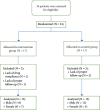The Effectiveness of Synbiotic on the Improvement of Clinical Symptoms in Children with Eosinophilic Esophagitis
- PMID: 35295822
- PMCID: PMC8920610
- DOI: 10.1155/2022/4211626
The Effectiveness of Synbiotic on the Improvement of Clinical Symptoms in Children with Eosinophilic Esophagitis
Abstract
Background: Eosinophilic esophagitis (EoE) is an allergic inflammatory disorder of the esophagus. Today, probiotics are included as adjuvant therapy in the treatment of allergic diseases. The aim of this study was to assess the effect of synbiotic on clinical symptom improvement in EoE patients.
Methods: This study is designed by a double-blind, placebo-controlled clinical trial with two parallel groups, which was performed on 30 children with eosinophilic esophagitis. All participants were children aged 6 months to 15 years. Both groups received the same treatment (elimination diet, topical steroid, and proton pump inhibitor). A synbiotic (KidiLact) was added to the medication regimen of 15 patients (case), while the next 15 patients received a placebo (control). Severity and frequency of symptoms were assessed with a checklist derived from a validated scoring tool in both groups before and after 8 weeks of treatment.
Results: There was a significant reduction in the severity score of chest pain and poor appetite (P value < 0.05) in the case group taking probiotics, while nausea and poor appetite were the only symptoms with a significant reduction in the frequency score after intervention in this group.
Conclusion: Probiotics can be used as adjuvant treatment for patients with EoE. Improvement in the severity of chest pain and poor appetite and reduction in the frequency of nausea and poor appetite in these patients can be seen.
Copyright © 2022 Niloufar Amini et al.
Conflict of interest statement
The authors declare that they have no conflicts of interest.
Figures
References
-
- Furuta G. T., Liacouras C. A., Collins M. H., et al. Eosinophilic esophagitis in children and adults: a systematic review and consensus recommendations for diagnosis and treatment: sponsored by the American Gastroenterological Association (AGA) Institute and North American Society of Pediatric Gastroenterology, Hepatology, and Nutrition. Gastroenterology . 2007;133(4):1342–1363. doi: 10.1053/j.gastro.2007.08.017. - DOI - PubMed
-
- Sampson H. A., Anderson J. A. Summary and recommendations: classification of gastrointestinal manifestations due to immunologic reactions to foods in infants and young children. Journal of Pediatric Gastroenterology and Nutrition . 2000;30(Supplement):S87–S94. doi: 10.1097/00005176-200001001-00013. - DOI - PubMed
-
- Hernandez-Trujillo V. Serum immunoglobulin E (IgE) measurement and detection of food allergy in pediatric patients with eosinophilic esophagitis. Pediatrics . 2011;128(Supplement 3):S109–S110. doi: 10.1542/peds.2011-2107CC. - DOI
LinkOut - more resources
Full Text Sources


